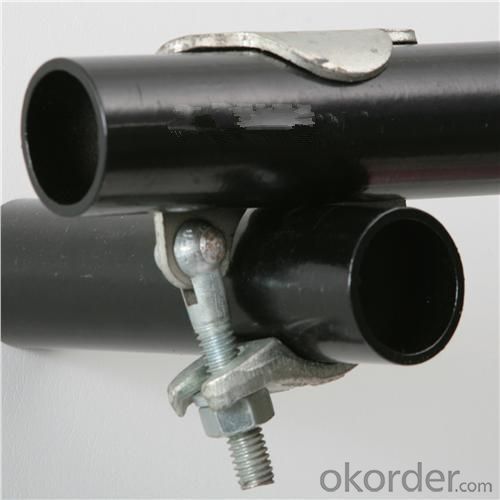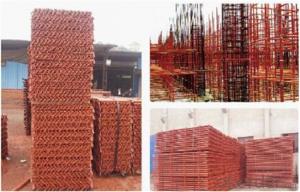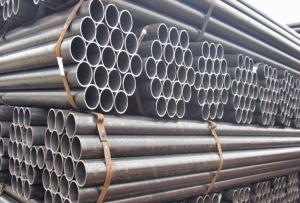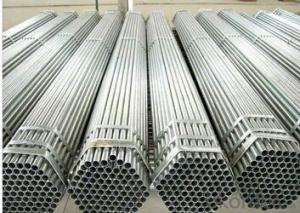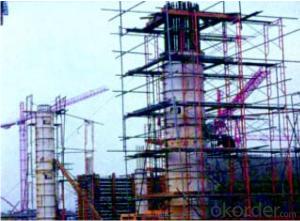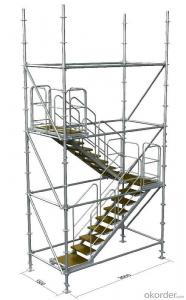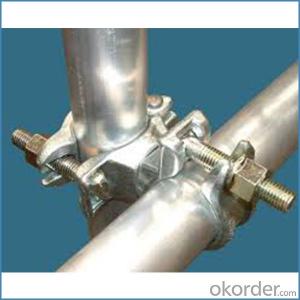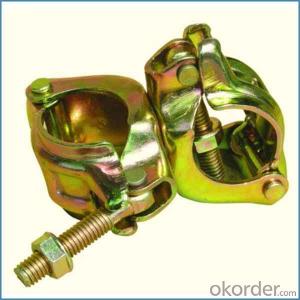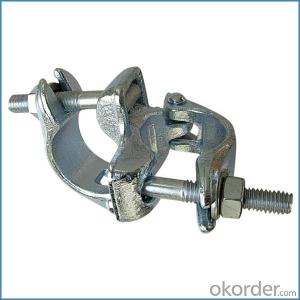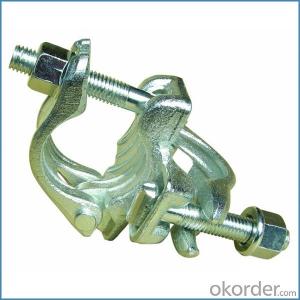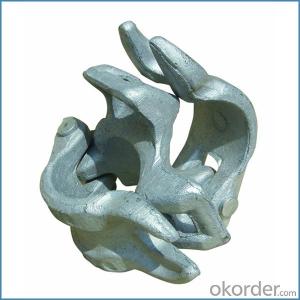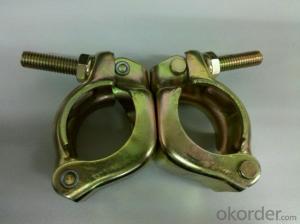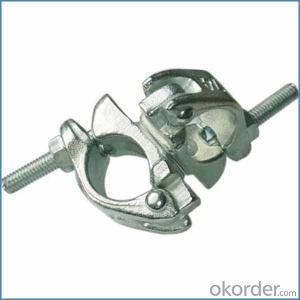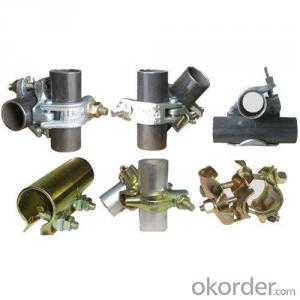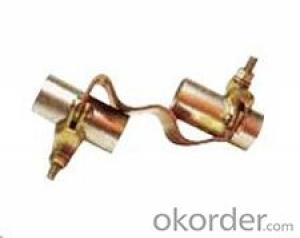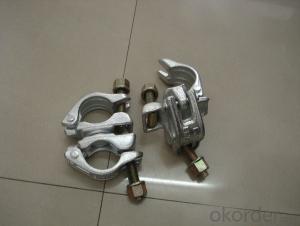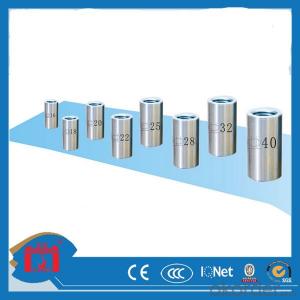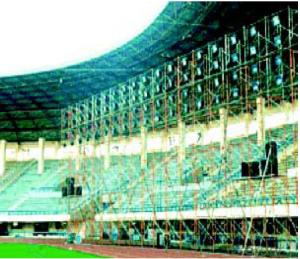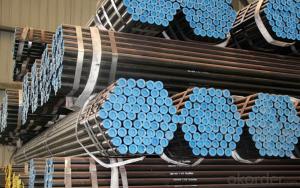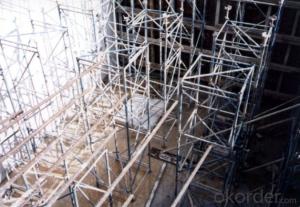Scaffolding Double Clamp british German Forged Type
- Loading Port:
- Tianjin
- Payment Terms:
- TT OR LC
- Min Order Qty:
- 1000 kg
- Supply Capability:
- 100000 kg/month
OKorder Service Pledge
OKorder Financial Service
You Might Also Like
Scaffolding Double Clamp british German Forged Type
Description
1.The scaffolding coupler is always used to connect the steel pipe as scaffolding system.
2.The often used coupler is swivel coupler and righ angle coupler .
3.We can provide types of scaffolding coupler according to your requirement.
4.Couoler can fix the 48.3mm scaffolding steel pipe tightly and make the whole scaffolding system more steadily.
Feature
(1)Excellent Anti-Breaking—Cold Pressed Steel
(2)Outstanding Resistance Deformation
(3)Strong Anti-Dropping Ability
Photo
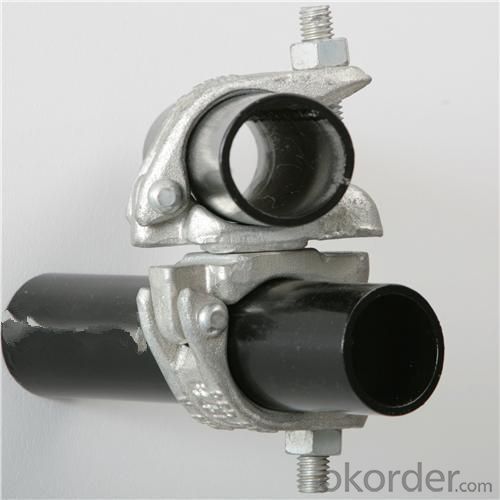
Parameter
| Material | Q235,345steel |
| Size | 48.3mm*48.3mm |
| Surface finish | Galvanized |
| Weight | 1.1kg around |
| Standard | BS1139,EN74 |
| Package | 25pcs/bag,steel pallet |
| Manufacture | As per customer requirement |
| Market | Africa, South America, the Middle East and Asia |
FAQ
Q: Are you a factory or trading company?
We are a state-owned corporation in China,dealing with various kinds of building materials.We have our holding subsidiaries.
Q: Where is your factory located? How can I visit there?
Our factory is located all around China.
Q: Can I get some samples?
Sample is free, customer only pay freight for the first time.
Q: Delivery?
10-30days. (5-15 containers)
Any question,feel free to contact us.
- Q: How do you ensure proper alignment when connecting steel tube couplers in temporary scaffolding?
- To ensure proper alignment when connecting steel tube couplers in temporary scaffolding, it is important to follow these steps: 1. Start by ensuring that all couplers and tubes are clean and free from dirt or debris that could affect their alignment. 2. Use a spirit level or a laser level to check the vertical and horizontal alignment of the tubes. This will help ensure that the scaffolding structure is level and stable. 3. Ensure that the couplers are securely tightened using a suitable wrench or spanner. This will prevent any movement or misalignment once the scaffolding is in use. 4. Double-check the alignment after connecting each coupler to ensure that they are properly aligned and in the correct position. 5. Regularly inspect the scaffolding structure to ensure that the alignment is maintained throughout its use. Any signs of movement or misalignment should be addressed immediately to prevent accidents or structural failure. By following these steps and paying attention to detail, proper alignment can be achieved when connecting steel tube couplers in temporary scaffolding, ensuring a safe and stable working platform.
- Q: How do steel tube couplers prevent slippage or movement of scaffolding tubes?
- By securely and reliably connecting scaffolding tubes, steel tube couplers effectively prevent slippage or movement. These couplers tightly grip the ends of the tubes to ensure they remain in place and do not slide or shift during use. The design of steel tube couplers incorporates internal teeth or gripping mechanisms that engage with the surface of the tubes, creating a strong connection. When the coupler is tightened, these teeth or mechanisms dig into the tube's surface, effectively preventing slippage. Moreover, steel tube couplers often come equipped with bolts or locking mechanisms that further enhance the stability of the connection. These bolts are tightened to create a firm grip and eliminate any potential movement or rotation of the tubes. In addition, steel tube couplers are typically made from high-quality steel, which provides excellent strength and durability. This ensures that the couplers can withstand the weight and forces exerted on the scaffolding, reinforcing their ability to prevent slippage or movement. Overall, the role of steel tube couplers is crucial in maintaining the stability and safety of scaffolding structures. Their secure connection prevents any unwanted slippage or movement, enabling workers to perform their tasks confidently and ensuring the integrity of the scaffolding system.
- Q: Are there any specific guidelines for using steel tube couplers in high-rise scaffolding?
- Yes, there are specific guidelines for using steel tube couplers in high-rise scaffolding. These guidelines are put in place to ensure the safety and stability of the scaffold structure. Firstly, it is important to use only steel tube couplers that comply with relevant standards and regulations, such as those set by the Occupational Safety and Health Administration (OSHA) in the United States or the Health and Safety Executive (HSE) in the United Kingdom. These standards dictate the strength, dimensions, and quality of the couplers, ensuring they are suitable for high-rise scaffolding. Secondly, it is crucial to properly inspect and maintain the steel tube couplers before and during their use. Regular inspections should be conducted to check for any signs of damage, such as cracks, deformations, or corrosion. Couplers that are damaged or compromised should be immediately replaced to prevent any potential failures or accidents. Furthermore, the correct installation procedures must be followed when using steel tube couplers in high-rise scaffolding. This includes ensuring that the couplers are securely tightened, with the specified torque, to provide a strong and stable connection between the tubes. Over-tightening or under-tightening the couplers can lead to instability or failure of the scaffold structure. Additionally, it is important to consider the load-bearing capacity of the steel tube couplers. The maximum load that the couplers can support should not be exceeded, and the scaffold should be designed and constructed in a way that evenly distributes the load across the couplers and tubes. This helps to prevent overloading and ensures the scaffold remains stable and safe. Finally, it is recommended to seek professional advice and guidance when using steel tube couplers in high-rise scaffolding. Consulting with a qualified engineer or scaffold designer can help ensure that the couplers are being used correctly and that all safety requirements are met. Overall, following these specific guidelines for using steel tube couplers in high-rise scaffolding is essential to maintain the safety and stability of the scaffold structure and prevent accidents or failures.
- Q: Anyone know how much they are in Public Image? :)Try not to put a stupid answer. :) ta.
- Try not to put a stupid question. Call the place and find out. Customer service is free.
- Q: Can steel tube couplers be used in scaffolding projects that require temporary enclosure or containment?
- Yes, steel tube couplers can be used in scaffolding projects that require temporary enclosure or containment. Steel tube couplers are commonly used in scaffolding as they provide a strong and secure connection between scaffolding tubes. They can be easily used to construct temporary enclosures or containment structures by connecting the necessary scaffolding tubes together.
- Q: Are steel tube couplers resistant to shear or bending forces in scaffolding structures?
- To withstand both shear and bending forces in scaffolding structures, steel tube couplers are specifically designed. Made of high-quality steel, these couplers provide exceptional strength and durability. Their purpose is to securely connect steel tubes in various configurations, ensuring the stability and integrity of the scaffolding system. When it comes to shear forces, steel tube couplers possess a robust design that enables them to endure substantial lateral loads. They firmly grip the tubes, preventing any slippage or movement, even under heavy or dynamic forces. This resistance to shear forces guarantees the stability and safety of the scaffolding structure. Similarly, steel tube couplers are engineered to resist bending forces that may arise from uneven weight distribution or external loads. Their rigid construction offers resistance against bending, ensuring that the scaffolding structure maintains its shape and stability. Additionally, steel tube couplers undergo stringent testing and adhere to industry standards to ensure their resistance to both shear and bending forces. These tests involve subjecting the couplers to forces and loads to evaluate their strength and performance in real-world conditions. Consequently, steel tube couplers have been proven to be highly resistant to both shear and bending forces. Overall, steel tube couplers are an indispensable and dependable component of scaffolding structures. They possess excellent resistance to shear and bending forces, contributing to the stability and safety of scaffolding systems. For this reason, they are the preferred choice in the construction industry.
- Q: How do you dismantle and remove steel tube couplers from scaffolding?
- To dismantle and remove steel tube couplers from scaffolding, you typically need to follow a few steps. First, ensure that the scaffolding is stable and secure. Then, use a wrench or scaffold spanner to loosen the bolts or nuts that hold the couplers in place. Once the bolts are loosened, you can remove them completely and detach the couplers from the scaffolding tubes. It is important to exercise caution and follow safety guidelines while dismantling the couplers to prevent any accidents or injuries.
- Q: Are steel tube couplers suitable for scaffolding projects in extreme temperature conditions?
- Yes, steel tube couplers are suitable for scaffolding projects in extreme temperature conditions. Steel is a highly durable and robust material that can withstand a wide range of temperatures without compromising its structural integrity. Therefore, steel tube couplers can be relied upon to provide a secure and stable connection between scaffolding tubes even in extreme temperature conditions.
- Q: What are the typical applications or industries that use steel tube couplers in scaffolding?
- Steel tube couplers are commonly used in the construction industry for various applications, particularly in scaffolding systems. Scaffolding is used to provide a temporary support structure for workers and materials during construction, maintenance, or repair projects. Steel tube couplers play a crucial role in connecting and securing the different components of scaffolding systems. The typical applications or industries that use steel tube couplers in scaffolding include: 1. Construction: Steel tube couplers are extensively used in construction projects of all sizes and types. Whether it's building residential structures, commercial buildings, bridges, or industrial facilities, scaffolding is an integral part of the construction process. Steel tube couplers ensure the stability and safety of the scaffolding structure, allowing workers to carry out their tasks at various heights. 2. Maintenance and Repair: Scaffolding is commonly employed for maintenance and repair work on existing structures such as buildings, bridges, or infrastructure. Steel tube couplers enable the assembly of scaffolding units that can be easily adjusted to fit the specific requirements of each project. This versatility allows workers to access hard-to-reach areas and perform necessary repairs or maintenance tasks effectively. 3. Oil and Gas Industry: The oil and gas industry often relies on scaffolding for various tasks such as construction, maintenance, and inspection of refineries, platforms, and pipelines. Steel tube couplers are crucial in ensuring the stability and strength of scaffolding structures in these harsh environments. They are designed to withstand extreme conditions, including high temperatures, corrosion, and heavy loads. 4. Power and Energy Sector: Power plants and energy facilities require scaffolding during construction, maintenance, and repair work. Steel tube couplers are used to connect the tubes and other components of scaffolding systems, providing a strong and reliable support structure for workers. These couplers can withstand the demanding conditions found in power plants, such as high temperatures and exposure to chemicals. 5. Infrastructure Projects: Infrastructure projects, including roads, bridges, tunnels, and railways, often require scaffolding for construction and maintenance purposes. Steel tube couplers are used extensively in these projects to ensure the safety and stability of scaffolding structures, allowing workers to access different areas for construction or repair work. Overall, steel tube couplers are widely used in the construction, maintenance, and repair industries, particularly in scaffolding applications. They offer a secure and reliable connection between scaffolding components, ensuring the safety and stability of the structure. These couplers are essential in various sectors, including construction, oil and gas, power and energy, and infrastructure projects.
- Q: Are there any specific guidelines for the safe use of steel tube couplers in scaffolding systems with electrical hazards?
- Yes, there are specific guidelines for the safe use of steel tube couplers in scaffolding systems with electrical hazards. Here are some key guidelines to follow: 1. Conduct a thorough risk assessment: Before using steel tube couplers in a scaffolding system with electrical hazards, it is important to conduct a comprehensive risk assessment of the work area. Identify all potential electrical hazards, such as overhead power lines or exposed electrical equipment, and assess the risks associated with them. 2. Use non-conductive couplers: When working in areas with electrical hazards, it is recommended to use non-conductive couplers made from materials such as nylon or composite. These non-conductive couplers help to minimize the risk of electric shock or electrocution by preventing the flow of electricity through the scaffold structure. 3. Maintain a safe distance from electrical hazards: Ensure that the scaffolding system is set up at a safe distance from any electrical hazards. Consult local regulations and guidelines to determine the required minimum clearance distance, which may vary depending on the voltage of the electrical source. 4. Insulate the scaffold structure: If it is not possible to maintain a safe distance from electrical hazards, consider insulating the scaffold structure. Use insulating materials such as rubber or plastic sleeves to cover the steel tubes and couplers, creating an additional layer of protection against electrical currents. 5. Train workers on electrical safety: Provide comprehensive training to all workers involved in the scaffolding operation, emphasizing the specific risks associated with electrical hazards. Ensure that they are aware of the proper use of steel tube couplers in these situations and understand the importance of following safety protocols. 6. Regular inspections and maintenance: Regularly inspect the steel tube couplers and the entire scaffolding system to identify any signs of damage or deterioration. Replace any faulty or damaged couplers promptly to maintain the integrity of the structure and minimize the risk of electrical hazards. 7. Comply with applicable regulations: Always adhere to local regulations, industry standards, and guidelines related to the use of steel tube couplers in scaffolding systems with electrical hazards. Ensure that the scaffolding system meets all safety requirements and obtain any necessary permits or approvals before commencing work. By following these guidelines, you can help ensure the safe use of steel tube couplers in scaffolding systems with electrical hazards, minimizing the risk of accidents and promoting a safe working environment.
Send your message to us
Scaffolding Double Clamp british German Forged Type
- Loading Port:
- Tianjin
- Payment Terms:
- TT OR LC
- Min Order Qty:
- 1000 kg
- Supply Capability:
- 100000 kg/month
OKorder Service Pledge
OKorder Financial Service
Similar products
Hot products
Hot Searches
Related keywords



